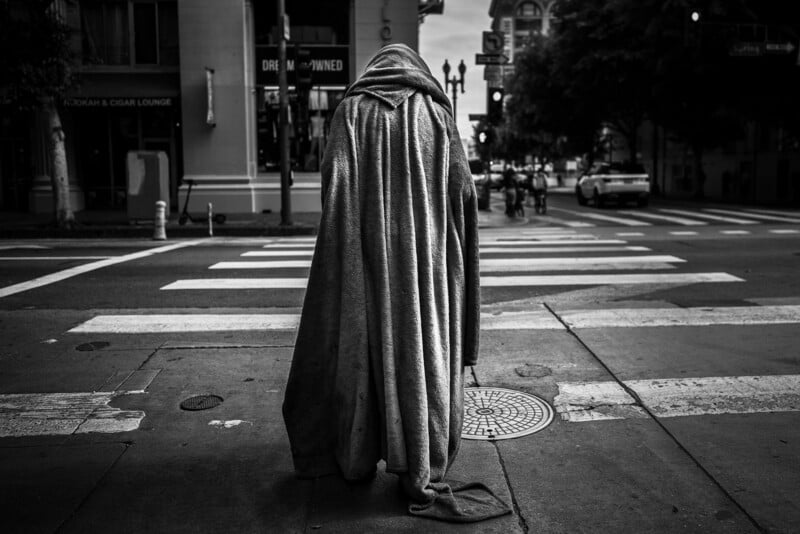Photographer’s ‘Street People’ Series Aims to Show America the Plight of the Homeless

For years, street photographer Irving Greines avoided documenting homeless people feeling that taking photos is intrusive and exploitative. Eventually, though, he felt compelled to document the growing unhoused population.
Los Angeles, where Greines is based, has seen homelessness rise in recent years with an estimated 75,000 people living in temporary accommodation.
81-year-old Greines tells PetaPixel that he has noticed the increase and has also observed the general public doing their best to avoid looking at, communicating with, and interacting with the unsheltered population.
![]()
![]()
![]()
Greines says that for years he refrained from taking photos of what he saw because he felt it was wrong. But a few years ago, he felt a compulsion to document what he was seeing.
“As a photographer, I needed to capture what I was seeing…The conflict was real,” he says
“Eventually, and with great reluctance and hesitation, I started photographing the street people, not knowing that the first photographs would lead to others and others.”
![]()
![]()
![]()
Greines says he set rules. Taking the opposite approach to most people; he opted to communicate and interact with all the homeless people he came across. He also promised himself to never profit from the images.
“I exclusively document with the hope that, upon viewing the images, others might observe, understand, and be motivated to alleviate some of the awful conditions under which fellow Americans are living,” he says.
Greines believes the project has changed his life.
“I have had innumerable encounters with real people, living real lives without any of the conveniences that I have always enjoyed,” he says.
“I’ve made friends with the street people and have grieved their unexplained disappearances. They have enriched my life.”
Engaging With Homeless People
Greines says he always approaches his subjects “in the friendliest manner possible” and never asks them to pose. Sometimes, after he’s taken an individual’s picture he will make a print for them which is often welcomed — occasionally with emotion.
![]()
![]()
![]()
However, engagement is not always possible. Sadly, homelessness is associated with mental health issues, drug addiction, and veterans suffering from PTSD; among other ailments.
“On relatively rare occasions, there is abuse. Some subjects are hostile and respond angrily and aggressively,” says Greines. But, he says, these incidents are rare. Although he sometimes faces abuse from bystanders who strongly object to his work.
“I get it and certainly understand why some might object to what I’m doing,” explains Greines. “I don’t think they are wrong; they simply have no way of knowing or understanding the documentary purpose of the project. Even with such knowledge, I acknowledge that some could legitimately object. I get it.”
Street Photography Setup
Greines uses a simple camera setup (a Sony a7R III and one wide lens) that he keeps strapped to his wrist so he is always ready to shoot.
“I use only one lens because I feel that having more than one lens impedes the fluidity needed in an active street environment. I make my one-lens set up work, and I use my feet as my zoom.”
![]()
![]()
Ethics
Greines understands why some people object to his documentary project and says he refrained from capturing homelessness for years because of the same ethical issues.
“Just as ethical concerns can legitimately arise concerning my documentation of the street people, similar concerns can likewise pertain to other documentary efforts of people living in awful circumstances; consider, for example, the images of Capa, Salgado, Nachtwey and many others,” he says.
“Documentary efforts like these can legitimately be viewed as exploitative, demeaning, et cetera. Yet, all reveal life as it is. Whether that is worthwhile is for others to debate and decide.
“I wrestled with these concerns for years before commencing the project. For reasons I’ll never completely understand, I crossed the Rubicon many years ago, after years of restraining.”
![]()
![]()
“And, while I understand and sympathize with those who might legitimately criticize, documenting was something I simply had to do,” he continues.
“The sadness of the lives of my subjects can only be alleviated if others, who have refused to see or have not had occasion to see, actually see.
“My goal in documenting the street people is to try to prompt people to see and understand, not avoid, so that, maybe, political solutions might emerge.”
More of Greines’ work can be found on his website and Instagram.
Image credits: All photos by Irving Greines.